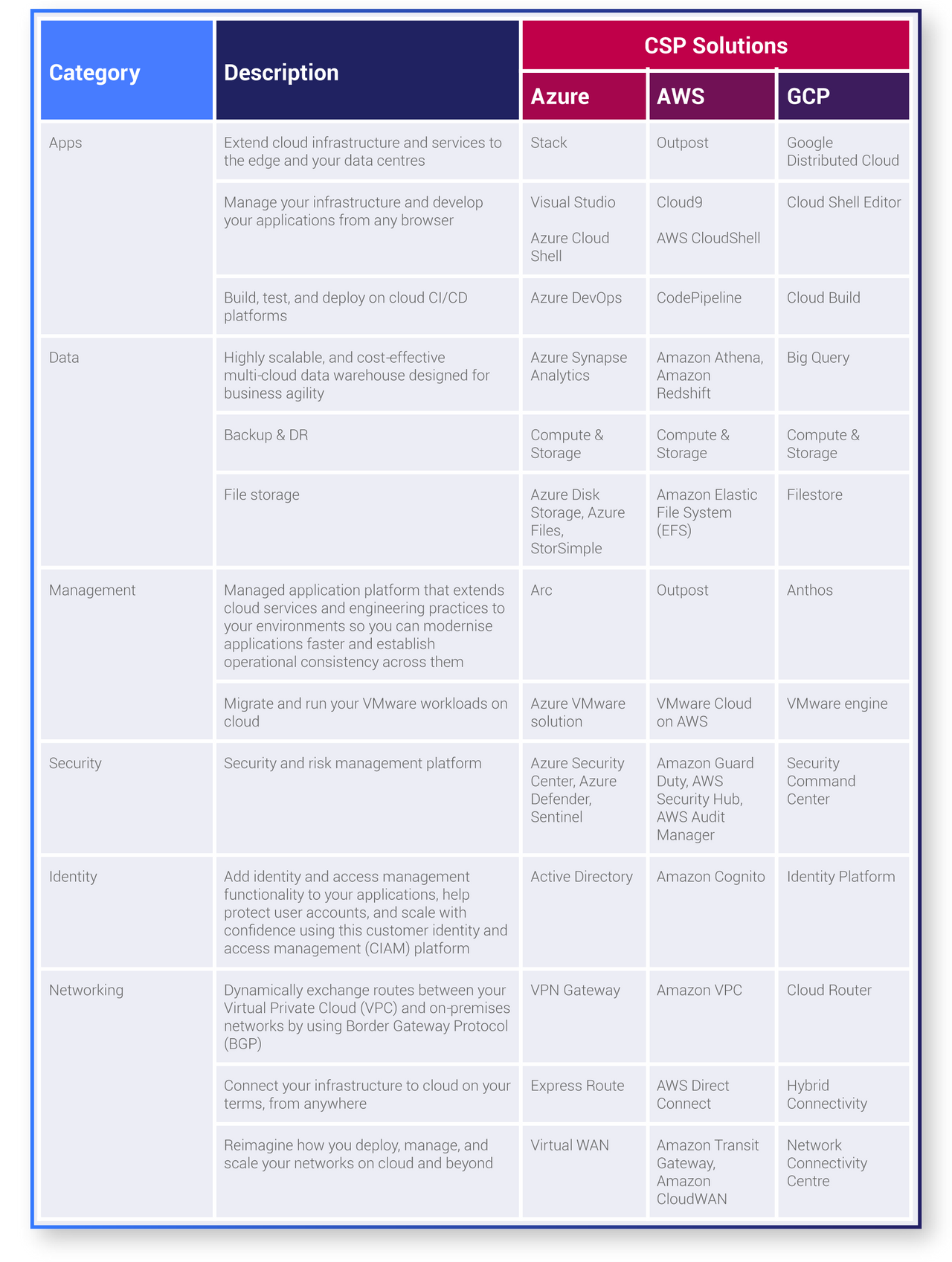How a Hybrid Cloud Solution Can Help You Leverage Value From Existing Investments
Deciding which platforms to host your workloads on comes down to where you can maximise the most value. Value in this case might translate to ease of deployment, the best licensing model, maximising utilisation, or making sure that you are sweating your existing assets.
Rather than focusing on putting everything into the cloud, you might find it more practical to adopt a hybrid approach where certain workloads are hosted in private cloud and others in public cloud. The approach from major cloud service providers (CSPs) to integrating private and public platforms gives you the opportunity to strike a balance between the two.
In this blog, we’ll look at what hybrid cloud is as well as its benefits and why it might be the right choice for you. We’ll share a few popular options available from major CSPs and weigh up the pros and cons so you can make the most informed choice.
What Is Hybrid Cloud?
Hybrid cloud means you can use the best of private and public cloud to provide environments that give you the flexibility and value you need to operate effectively. It offers the ability to manage and orchestrate workloads across multiple environments which could include any number of public or private cloud environments, bare-metal or virtualised environments, or Software as a Service (SaaS) offerings.
A well-designed hybrid cloud gives you the ability to manage your workloads across these environments as one coherent environment. In order to achieve this, a hybrid cloud requires management tooling to abstract the complexity of the many APIs and tools you would normally use to interact with the individual components.
Why Hybrid Cloud?
Public vs Private vs Hybrid Cloud
As more large and multinational enterprises embrace cloud, they are looking to leverage all the benefits cloud has to offer whilst still gaining maximum value from existing investments that have been made in data centres etc. Just because you have adopted a cloud first approach doesn't mean that you have to walk away from previous large investments that still have the opportunity to provide value for the duration of their working/economic life.
There are also cases where a cloud deployment is not suitable, such as there being a requirement for specialist hardware or security and regulatory policies that prevent certain data or applications from being deployed in the public cloud.
Having a hybrid cloud strategy can lead to an increased maintenance overhead due to the increase in complexity of dealing with multiple clouds and APIs. However CSPs have recognised this and in response they have developed tools that allow you to manage both private and public assets. As a result, the maintenance of hybrid cloud environments has become much more efficient.
Hybrid Cloud Uses
Hybrid cloud is a two-way street. It can be used as a solution to move your workloads into the cloud but it can also be used in the opposite direction allowing you to integrate cloud services into your private environments that might otherwise be impractical.
For example, you can:
- Provide global load balancing and DNS for on-premise environments
- Provide offsite backup using cloud storage
- Monitor internal applications and servers
- Monitor security of internal assets
- Provide identity services for on-premise environments
- Use public cloud as a DR destination allowing you to fully utilise on-premise assets
- Deploy hardware on-premise that offers a management experience very similar to that of public cloud
Azure, AWS and GCP all offer products that allow you to deploy on-premise hardware that offers a similar user experience to that of their public cloud offerings, sometimes referred to as cloud-in-a-box solutions. These give a reduced subset of services but do provide some consistency with the aim of a simplified management experience. The area that this blog will focus on is using cloud-in-a-box services to act as an enabler for providing environments when developing applications for internal or public cloud deployment.
What Are the Benefits of Hybrid Cloud?
1. Manages costs
Hybrid cloud means you can house your core, business-critical and sensitive data on private, on-premise servers while offloading less sensitive data and applications to the public cloud. Conversely you may find it more cost-effective to provide development resources from highly utilised local environments for applications intended to run in the cloud.
When deciding if you want to use a hybrid cloud model it’s important to be aware that on-premise spend will, most likely, come out of your capital expenditure (CapEx) and public cloud will be classed as operating expenditure (OpEx) due to its subscription model.
If you’re considering adopting hybrid cloud then you need to ensure that your budgets account for the different financial models in your overall platform strategy. This means you can commit your CapEx to things you know need to be on-premise, while using OpEx budget to flex quickly using cloud services e.g. adapting to changing demand and storage needs so you’re only paying for resources you use. If the demand drops again, the cost will also decrease back to previous levels and you won’t have a large amount of excess hardware that you’ve spent a lot of money on.
2. Improves data and risk management
Hybrid cloud will allow you to choose where to house your data and workloads based on compliance, policy, or security requirements. This means that you will be able to store your data wherever it will provide the most value based on your own policies.
Making best use of hybrid cloud’s centralised management also makes it easier to implement strong technical security measures such as encryption, automation, access control, orchestration, and endpoint security so you can manage risk effectively.
3. Closer to advanced features
Having a hybrid cloud model enables you to treat your cloud and local networks as one. This gives you the ability to take advantage of the best that both have to offer and integrate private and public cloud systems in new and innovative ways. For example:
- A local environment can be monitored using platform and security monitoring tools in the cloud
- On-premise systems can have access to advanced data tooling in the public cloud
- Backups can be made locally and moved to cloud storage
4. Business continuity
Hybrid cloud models can be used to improve business continuity and reduce potential downtime and the resulting costs.
For example, a hybrid cloud enables you to back up key data, by replicating business-critical data to the cloud, and ensures scalability in the event of a spike in demand. This also means that you do not have to have large amounts of redundant hardware in your data centres to cover disaster recovery scenarios. If you need to recover to the cloud you only pay for the servers/services when you are using them.
5. Increases agility and innovation
Being able to respond quickly to changes in demand is a key factor for innovation and competition. A hybrid cloud model should help you to increase your speed to market by optimising performance and providing the flexibility you need to respond to changing business needs.
With a hybrid cloud strategy you aren’t limited to private on-premise infrastructure, you can easily expand workloads on the cloud and quickly test, prototype, and launch new products.
6. Improves scalability and control
As your business needs evolve and the demand for IT services fluctuates, you will be able to scale your workloads as you need.
If you also make good use of the hybrid cloud tooling available, you will be able to create repeatable Infrastructure as Code (IaC) across your hybrid environments in order to enforce consistency and repeatability.
How to Plan a Hybrid Cloud Strategy
Is Hybrid Cloud Right for Me?
You have decided that you want to explore the use of local development environments. Before you dive into implementing anything however, there are a series of steps that you need to go through to make sure that using a hybrid cloud strategy will give you the value and functionality that you want.
Ideally your organisation will have a robust set of hybrid cloud policies that will provide you with the questions that you need to ask yourself when deciding on the best course of action. They will ensure you consider:
- Finance and commercials
- Risk
- Security
- Management
- How technology is selected
If you don’t have these policies in place Contino can help! Get in touch here.
Establish the Current State for Your Development Environments
First of all you should build an accurate picture of your current development processes:
- How does the development workflow work?
- Who is involved?
- Does development happen locally on laptops or in dedicated environments?
- How are development environments commissioned and how long does it take?
- What tooling is used in the route to live?
- What level of automation is used on the route to live?
- How much does it cost?
- How is test data handled?
- Do you use shared databases? Are they local or in the public cloud?
- How representative of live environments are the development environments?
You should then spend some time considering whether your current development ways of working are appropriate and in alignment with your hybrid cloud policies before you start designing the future state of your development environments.
Design a Future State for Your Development Environments
You can now take the information you have gathered on your current ways of working along with any improvements you want to make to decide upon the best technology to use and design your future state.
To help you decide if a hybrid cloud solution is right for you, consider:
- How do the costs compare between the current state, a public cloud solution or a hybrid cloud solution?
- Do you have a good idea of capacity requirements for the life of your solution?
- Does the solution meet security and privacy requirements?
- Does the solution allow you to align with your ways of working?
- What impact will there be for technical teams that need to manage and maintain?
- Do you have the skills to develop the tooling you need to get the most out of your solution?
If everything stacks up and a hybrid cloud solution makes sense then it's time to confirm your technology choices and update your cloud operating model to capture any process changes you have decided to make.
What Are the Hybrid Cloud Options?
All of the major CSPs offer a variety of services that can help you to build out your hybrid cloud environments. They give you the ability to flex out to the cloud, host services in the cloud that integrate with your on-premise infrastructure, and manage your identity, networks and compute across cloud and on-premise.
The table below outlines some of the services provided by Azure, AWS and GCP that you can use to establish your hybrid cloud across application development and hosting, data, management, security, and networking.
What Are the Challenges of Hybrid Cloud?
There are a number of challenges to be aware of that go along with having a hybrid cloud solution.
1. Financial management
Firstly, from a financial point of view, hybrid cloud will require a mixture of capital and operating expenditure. If your organisation is still operating largely on the cloud then this is something that needs to be considered as you will be more set up for operating expenditure. If your organisation is used to buying and running hardware then this shouldn’t be a problem.
You need to ensure that your capacity planning for the hybrid environment is as accurate as possible. If you decide to implement a cloud-in-a-box solution, such as Stack or Outpost, then you are committing to a large multi-year investment and you want to be sure it will be useful for the duration of its life. You also want to make sure that you are not constantly having to make requests to expand capacity that will slow you down due to the procurement and commissioning lifecycle.
2. Sustainability
One of the strengths of using public cloud is that the providers all have plans for sustainability and carbon reduction. Deploying to the cloud can therefore support your own sustainability targets. If you’re hosting hardware yourself then you need to think about maintaining your environment and how you can mitigate that impact. Example of things to consider:
- Power consumption and where that power comes from
- Carbon footprint of hardware (manufacturing and transport)
- Carbon footprint of people required to manage the data centre
- Impact of backup generators
The more public cloud you use, the less you have to worry about these considerations.
3. Reliance on external vendors
Cloud-in-a-box solutions are very much a black box. There are certain admin tasks that you can carry out but for any deep troubleshooting you are reliant on a vendor remoting into your environment to find out what is wrong. This isn’t necessarily a challenge for everyone but might be for engineers who want to dive into the details.
4. Lack of feature parity between public and private cloud
From experience, the biggest drawback is the lack of feature parity between public cloud and private cloud offerings. It's good that you can manage the private aspects of your hybrid cloud using the same tools as public cloud, but you are limited by the services available to you. A huge benefit of public cloud is the seemingly limitless number of services and resources available. It isn’t practical for a CSP to offer every service available in public on a cloud-in-a-box solution so you need to be sure that, if you are developing on one, it gives you all of the services you need to be able to accurately simulate your live environments.
5. Ways of working
To make the most of your hybrid cloud, you need to ensure that your organisation has the ways of working in place that will enable the most value such as skills in automation and DevOps practices and tooling. If you don’t, it will be difficult to realise the full value of your investment.
In Summary
It is quite possible that, due to financial or regulatory requirements, a hybrid cloud solution could be the right solution for your organisation. In the case of development environments it will give you the opportunity to more densely utilise your hardware thereby offering increased value over hosting those environments in the public cloud.
Every organisation is different though, so it is important you ensure that hybrid cloud is the best solution for your organisation. To do this you need to make sure you fully understand your ways of working and hosting policies and have taken the opportunity to optimise them. You can then create a solution that truly fulfils your requirements.
If you’re considering hybrid cloud of any sort but are unsure if it is the best fit for your organisation then Contino can provide you with the expertise you need to make the right decisions.








